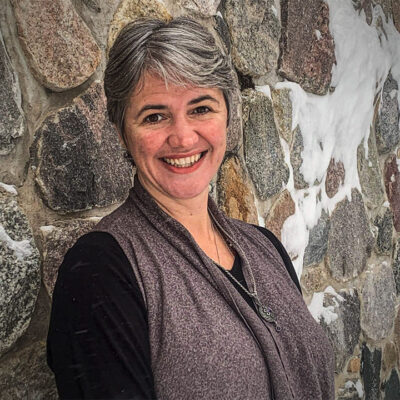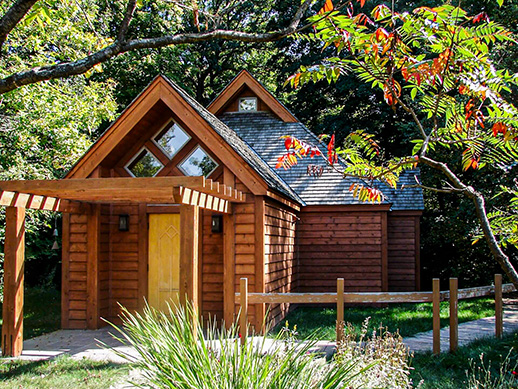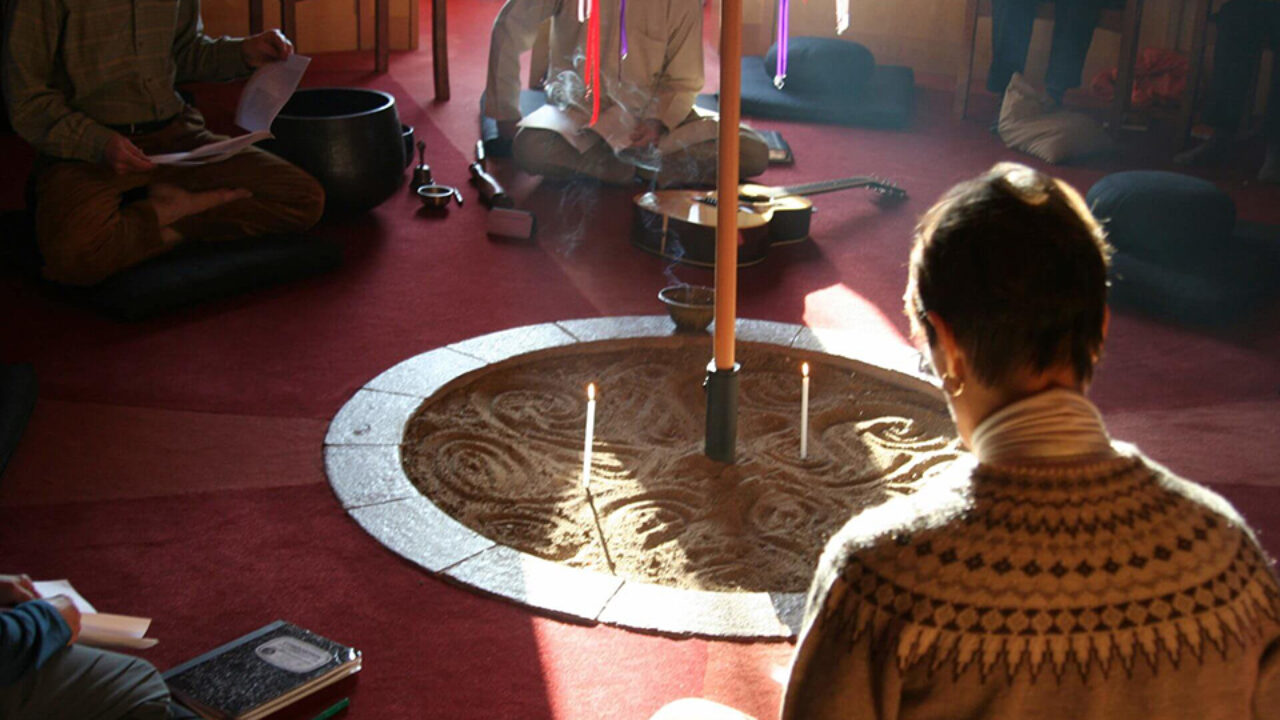The Sound of Community During the Lenten Season: Chant in the Episcopal House of Prayer
A sacred, ecumenical place dedicated to Benedictine hospitality, contemplative prayer, and collective rest, the Episcopal House of Prayer embraces the power of chant in expressing oneself and connecting to one’s fellow humans during the Lenten Season with The Saint John’s Bible.
Collegeville, Minnesota Finding a physical space for spiritual connection is just as important as creating that space within oneself. Spaces of this sort allow people to bring their whole selves into the equation. Especially for contemplative seekers, finding a sacred place to pause one’s rhythm, find rest, and reconnect with an inward space of spirituality is the epitome of the Episcopal House of Prayer.

Nestled within the maple woods on the edge of Saint John’s Abbey and University campus, this 12-room retreat center is an independent nonprofit where groups or individuals are welcome to come and experience the full embrace of hospitality. Guided by its mission “to assist in the ongoing work of discerning God’s presence, both within ourselves and the world,” the Episcopal House of Prayer invites people from all walks of life to experience the power of collective contemplation and to “befriend ambiguity.”
“What we hope for is that our guests come away to a place for rest and feel really well cared for when they’re here at the Episcopal House of Prayer,” said Dr. Christine Luna Munger, Director, Episcopal House of Prayer. “There’s this joke people say, ‘The Episcopal House of Prayer, come for the food and stay for the retreat.’ The food is good, and the beds are just as soft as the spiritual nourishment that you might experience here.”
“We are a little niche within the stream of Contemplative Christianity, and part of my role as Director is to work towards teaching contemplative prayer forms,” added Dr. Luna Munger. “However, this space is not exclusive to contemplative Christians, but is open to all different expressions of Christianity.”

The Episcopal House of Prayer is a place with community at its core. Conceptualized by Bob Anderson, former Bishop of the Episcopal Church in Minnesota, and Saint John’s Abbot Jerome Theisen, this sacred space was created for people in search of wisdom who are offered guidance as well as training in the inner work of spiritual life. In addition to monthly retreat offerings, the House of Prayer also gathers weekly for contemplative practices.
“‘Come away to a place apart.’ This is our tagline, written out on a beautiful watercolor painting in the House,” said Dr. Luna Munger. “The main idea is that sometimes, pausing one’s life to get out and rest is a good way to remember how you really want to live your life.”
Vocal Unison: Composing Community of Soundwaves
Anyone who participates in the Lenten season will know that it gets quite busy quite fast. So, while the House of Prayer tends to host fewer retreats during this time, it does take part in an annual day long Lenten Retreat by the name of Chanting the Psalms.
The House of Prayer’s state of sanctuary and reflection is, in many ways, similar to the ethos of the Lenten season. Lent invites us to sink into reflective practices, engage in holy tradition, and come together in observance of the many Holy Days of Lent.

For the House of Prayer, the invitation of Lent is less so a personal one, and very much communal in nature. On Chanting the Psalms, a small community gathers in the House of Prayer and, together, chants the entirety of the Psalms, starting from one and ending at 150. The House usually allots one entire day, from 9 a.m. to 3 p.m., for this practice. Prior to 2021, the House has used individual Psalm Books. Until 2021, when, after Dr. Luna Munger contacted the then-Abbot of Saint John’s Abbey, Abbot John Klassen, welcoming the monks of Saint John’s Abbey to join in the practice, Abbot Klassen and Fr. William Skudlarek, OSB, offered the Abbey’s edition of The Saint John’s Bible to the House for the day.
Enthusiastically, Fr. Skudlarek brought The Saint John’s Bible to the House of Prayer and set it on the center altar table in the main hearth room. All guests gathered around the Psalms volume and sang while Dr. Luna Munger turned the pages. The House of Prayer has used The Saint John’s Bible for Psalms Day every year since this first occurrence.
“We were just very excited that this work of sacred art was so accessible and present to us,” said Dr. Luna Munger. “Having the art and the music come together in prayer was really special.”
Indeed, there is something about chant that is really special. The presence of one collective, synchronous voice is a kind of spiritual practice that impacts the human spirit in an entirely measurable way.
“When I teach chant, I often tell people, ‘If you want to be a whole person, if you want to bring your whole self, holistically, you bring your head and your heart. Well, what’s the thing that’s located right in between your head and your heart, if not your voice, this place that you sing from?’” said Dr. Munger. “I often tell people that chant reminds us that we’re a whole person, that we bring our head and our heart into our work or into our encounters with others.”
After all, what is community, if not the practice of bringing one’s full self into an encounter with others? Of creating soundwaves together that draw upon the deepest, truest parts of oneself?
Dr. Luna Munger points to a story told by Cynthia Bourgeault, Episcopal Priest and writer, about a Monastery in Southern France. For centuries, this monastery had gathered and sang Gregorian chants. That is, until 1965, when a new tradition discontinued the practice of chant. A few weeks later, the monks of the church fell ill with distressing fatigue and symptoms of depression. For two years, the monks tried different remedies, but changing diets, altering work schedules, and medication all did nothing to help the ill monks.
Confusion filled the monastery. What could be wrong? The illness continued until, upon suggestion by prominent French doctor, Dr. Tomatis, the monks began their daily chanting ritual. It took only a few months for the monks to return to full health and energy.
Thus, Bourgeault concludes, what feeds the soul must also feed the body.
“There’s a way in which sound and vibration are not just symbols. There are real vibrations that connect us,” said Dr. Luna Munger. “When we sing in unison, our hearts become entrained. This means that, quite literally, our hearts start to beat together when we sing together for a period of time. It is a great symbol for world peace, unity and connection. To have The Saint John’s Bible as one unifying piece of sacred art physically and symbolically at the center of us during our chanting of the Psalms, enriched the experience even further.”
The Saint John’s Bible Heritage Program: Embrace Hospitality
To learn more about the Episcopal House of Prayer, visit their website or contact houseprayer@csbsju.edu or call (320) 363-3293.
To read more stories and JourneyNotes similar to this one, visit the blog or subscribe to the monthly e-newsletter, Sharing the Word.
To follow along with the Heritage Program in real time, follow @SaintJohnsBible on Instagram, Meta, and X.

